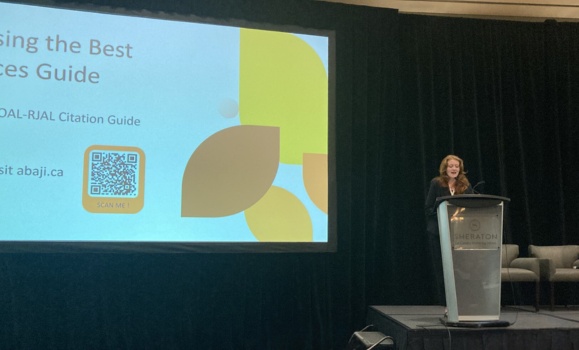News
» Go to news mainSchulich Law Launches Style Guide for Writing ±«Óătv Indigenous Peoples in the Canadian Legal Context

Naiomi Metallic (BA ’02, LLB ’05), Associate Professor and Chancellor’s Chair in Aboriginal Law and Policy, and Schulich Law’s Truth & Reconciliation Committee recently launched a style guide for Aboriginal law and Indigenous law.
The guide, titled  was prepared with the help of two students from the joint JD/Master of Information program, Kelti McGloin (JD/MI Candidate ’26) and Kate Anderson (’24), under the supervision of law librarians Jennifer Adams, David Michaels, and Hannah Rosborough.
“Although there has been some effort in recent years to establish stylistic conventions when writing for and about Indigenous Peoples, these guidelines have often been oriented toward specific professions, like journalism,” Metallic explains. “Since legal writing often engages with topics and terminology that may not be discussed at length in other areas, this resource seeks to assemble guidelines that are helpful to those in the legal profession.”
As the guide was authored in Mi’kma’ki, primarily for the use of law students at Schulich Law, particular attention is paid to terminology regarding the Mi’kmaq and Wolastoqewiyik Peoples. It shares best practices in terms of what terminology to use (Indigenous vs Aboriginal vs First Nation, etc.), tips on when to capitalize, and advice on using words in Indigenous languages.
“As Aboriginal law and Indigenous law gain more attention within the legal community, it is important to be informed about best practices when writing about these topics," adds McGloin. "These practices are evolving every day as Indigenous Peoples in what we now call Canada increasingly assert their right to self-determination and rightfully gain a louder voice in social, political, and legal spheres. Language is both shaped by, and plays a role in shaping, the world around it so it is vitally important that legal professionals are aware of how to best use language in respectful, effective ways.”
McGloin, who was the lead on the project, presented the style guide to delegates at the Canadian Association of Law Libraries (CALL) conference that was held in Montreal in late June 2024.
McGloin and Anderson consulted a variety of existing resources, including books, government websites, cultural sensitivity courses, and existing legal scholarship, in addition to consultations with subject matter experts at the law school. These resources were synthesized to create a more cohesive set of guidelines relevant specifically to the Canadian legal context.
The guide will be introduced this year to 1L students in LAWS 1014/1024 (Legal Research and Writing), as well as LAWS 1019/1029Â (Aboriginal and Indigenous Law in Context). Students in upper-year courses taught by Metallic and other faculty members will also be expected to adhere to it for assignments touching on Indigenous issues.
“The plan is to update it periodically as emerging trends in the field become established conventions,” says Anderson, who is currently working on a second style guide focusing on the citation of Indigenous law resources.
Best Practices for Writing ±«Óătv Indigenous Peoples in the Canadian Legal Context: An Evolving Style Guide for the Schulich School of Law at ±«Óătv University can be accessed via the .
Recent News
- Professor Elaine Craig ft in "Age‑verification laws won’t protect kids from porn – and they could even make things worse"
- Building a Solid Foundation of Wellness
- Associate Professor Jamie Baxter ft in "Dal researchers to lead national team to modernize Canada's soil data infrastructure"
- DLAS Community Legal Worker Mark Culligan ft in "±«Óătv Legal Aid sounding alarm about latest tenancy changes"
- Olabisi D. Akinkugbe Named Purdy Crawford Chair in Business Law
- Professor Colin Jackson ft in "First open access casebook on Canadian bankruptcy law releases second edition"
- Professor Rob Currie ft in "Open Letter to Canada Minister of Foreign Affairs on Bangladesh Crisis"
- Schulich Law Launches Style Guide for Writing ±«Óătv Indigenous Peoples in the Canadian Legal Context
